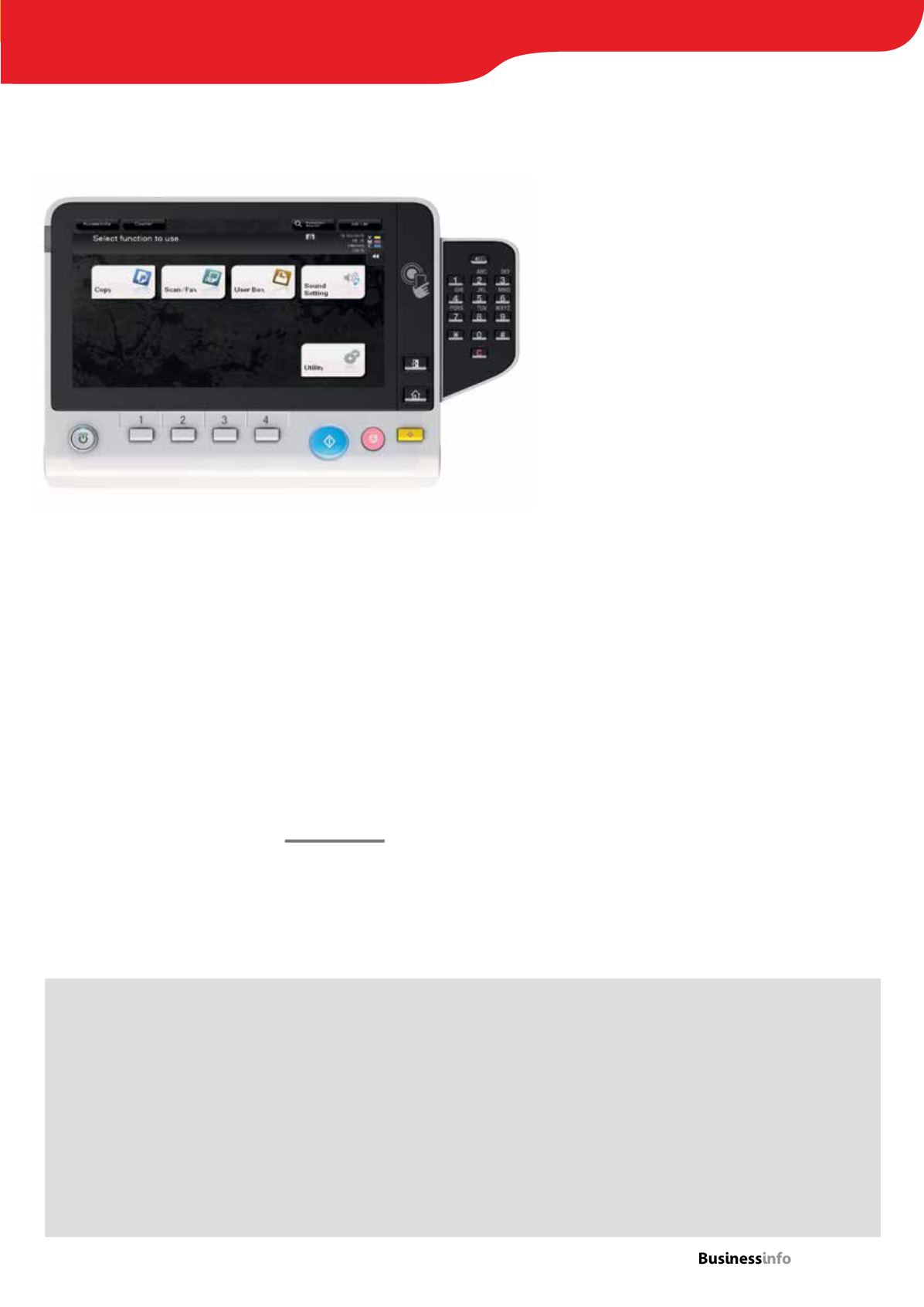
touchscreen interfaces. Not only does
this enable a more personalised approach
to printing, it’s clear to the user how to
interact with the device, which speeds up
the process,” he said.
“The actual act of copying remains
largely the same, but features such
as Auto Duplex, which has become a
standard feature in many devices, even
those at the lower end of the product
range, make it much faster to copy onto
both sides of paper, reducing cost and
time. The introduction of features such
as the touchscreen user interface and
Auto Duplex are changing the way in
which we print, making the process far
more efficient.”
He added: “Xerox ConnectKey devices
go a step further by allowing apps to
be loaded that enable end customers
to create their own workflows at the
touch of a button. This alters the whole
process of receiving a hard copy invoice
for example.When using the Xerox
ConnectKey device, the invoice can
be copied, scanned to the accounts
department e-mail address and
automatically archived in a document
magazine
01732 759725
21
Smartphones and tablets are changing the
way people use and manage documents,
but when it comes to printing, they are still
stuck in the PC era.
A new study by International Data
Corporation (IDC),
Mobile Device Users/Non-
Users: Print, Scan, Document Management,
Worldwide
, shows that while 90% of users
say it is as useful to print from a tablet/
smartphone as from a PC, only 56% are
satisfied with their mobile printing experience.
More than one third of smartphone and
tablet users say they want to print but are
unable to do so (35% and 34% respectively).
Angèle Boyd, Group Vice President and
General Manager, IDC Document Solutions,
said: “The business value for smartphone/
tablet printing is enormously clear, and yet
support for this is shockingly lacking in 2015.
This is a huge missed productivity opportunity
for both businesses and print providers.”
The four main benefits of printing from
smartphones/tablets, cited by between 32%
and 57% of respondents, are faster document
review; greater customer satisfaction; an
increased number of transactions; and the
ability to attract more customers.
IDC’s study shows that, due to small screen
sizes, smartphone and tablet users prefer to
read documents on a PC or paper than on a
smartphone or tablet.
Over the next three years, IDC expects the
proportion of prints from smartphones and
tablets to rise by around 50%, from 20-21%
today to 28-30% in 2018.
have PaperCut Embedded we’ll see a real
acceleration of sales.”
Paul Young from UTAX points out that
solutions platforms also allow vendors
to develop their own applications more
cheaply than ever. “Our HyPAS platform
allows Java and web-enabled apps to be
installed straight onto a machine. You
can have apps made specifically for each
organisation at a low cost. Previously, a
software solution could cost thousands
of pounds to produce; now one can be
deployed for a few hundred,” he said.
Mobile printing
With cloud connectivity andWiFi
becoming standard features and Near
Field Communication (NFC) appearing
on more and more devices, plus an ever
expanding range of mobile printing
solutions, it is easier than ever to print
where and when you want.
“Thanks toWiFi technology, printers
no longer need to be hard-wired and
you can now access, edit and collaborate
your documents in the cloud,” explained
Dave McNally, product marketing
director of Dell Imaging EMEA. “Users
can also print from a mobile device, such
as a phone or tablet, to a mobile-enabled
printer using the Dell Document Hub. If
you just want straightforward printing
this can be achieved using Dell Mobile
Print, AirPrint or Google Print, all of
which save time and effort.”
Paul Young argues that such features
are must-haves for small and medium-
sized businesses that are increasingly
reliant on flexible working practices.
“The need to print while home
working or out of the office, sometimes
in remote locations, is driving more
businesses to review the way their
employees prefer to print. Smartphones
and tablets are now standard business
tools and dedicated apps designed for
business allow organisations of all sizes
to leverage the convenience of being
repository –
all in a single
action!”
Embedded apps
The value of platforms
like ConnectKey is enhanced
by the ability to run third
party applications on devices.
This has such benefits that
embedded platforms are a real
selling point.
Mark Allen, for example, expects a big
boost in RIPS inkjet sales next year when
Epson brings out its own apps platform
and an embedded version of the popular
PaperCut printer management solution.
“We’ve got the introduction of
PaperCut Embedded coming along soon
– our own version of open architecture
and copy control software that we are
developing ourselves.We hope to have
our first beta version by January of next
year, but it will be more like March or
April before we have a final release.
Everything is agreed and signed off in
Japan.We know it’s there, which will give
us a level standing with other vendors,”
he said.
“At the moment we can use a
server-based version to track and keep
visibility of costs.What we can’t do is
embed it into the device itself, so that
you can go up to the device and swipe
your proximity card or log in by the ops
panel. Once we have that in March/April
we will be able to offer what the Top 10
vendors are offering now,” he said.
He added: “I think it will make a
massive difference to our sales.When we
Printers
Mobile print volumes to rise by 50%
...continued
continued...
Cloud
connectivity
and WiFi are
becoming
standard
features
and NFC is
appearing
on more and
more devices


